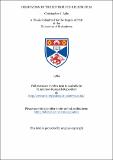Dissipation in the superfluid helium film
Abstract
Experimental apparatus to study dissipation in the saturated superfluid helium film has been developed. The low temperature parts comprise a sealed cell containing liquid helium, to which are affixed two parallel plate capacitors, functioning both as liquid reservoirs and as a way of measuring the liquid level. A small hole in a thin plastic film located in the flow path between the two capacitors forms the flow-limiting constriction. This arrangement introduces large velocity gradients in the vicinity of the hole. Film flow is initiated and sustained by an electric field in one capacitor, generated by a purpose-built Film Drive Unit (FDU) and a high-voltage amplifier. Detailed study of the helium film under steady flow conditions was not possible, but those results which were obtained indicate that the transfer rate is about 30% higher than was anticipated. By applying positive feedback to the film through the FDU, the inertial oscillations can be studied over many cycles. This new method has revealed some unexpected results, and a variety of types of oscillation behaviour have been observed. A theoretical model of dissipation has been developed, based on the premise that vortices in the film are oriented perpendicular to the film plane and are free to move and cross streamlines. According to this model, the large steady film transfer rates are due to the separation of the region of dissipation and the region of maximum velocity, an effect caused by the radial-flow geometry. Numerical simulation of the inertial oscillations using the model reproduces some of the behaviour observed experimentally, provided that the rate of vortex creation is taken to be a step function of the velocity. The shape of the liquid helium surface tension meniscus has been calculated numerically. The calculation is valid for the moving and static film in the absence of dissipation.
Type
Thesis, PhD Doctor of Philosophy
Collections
Items in the St Andrews Research Repository are protected by copyright, with all rights reserved, unless otherwise indicated.

